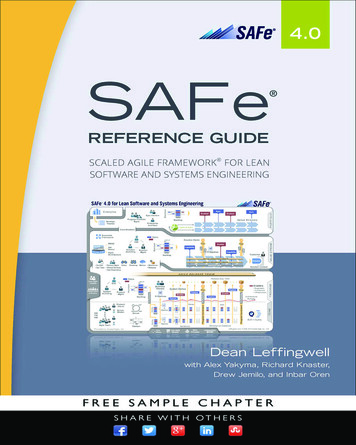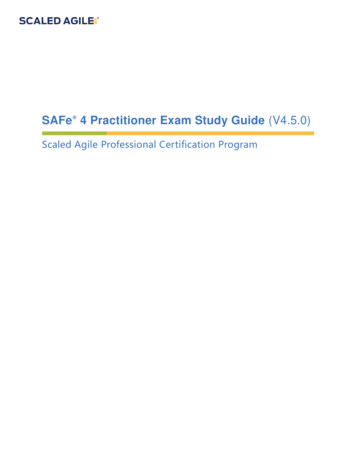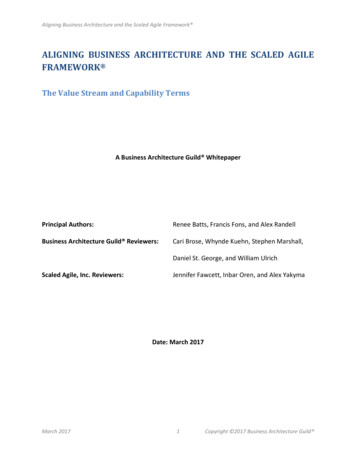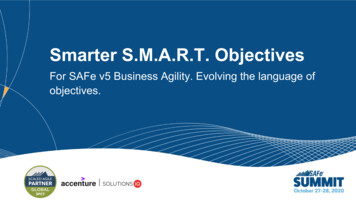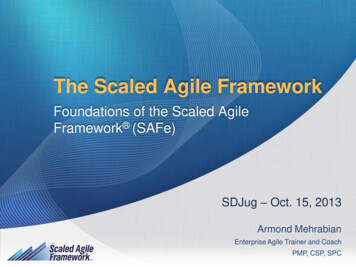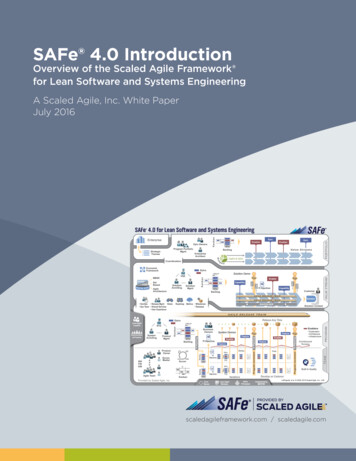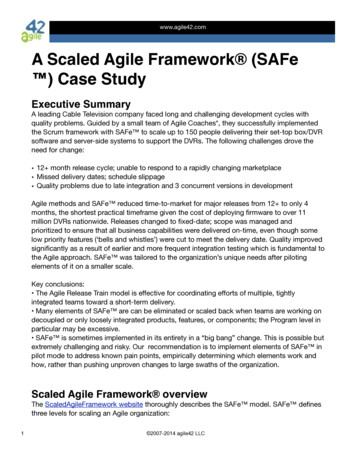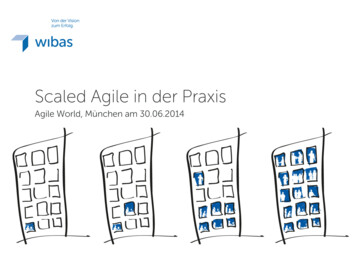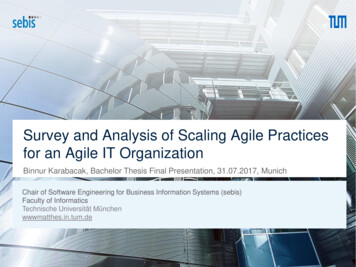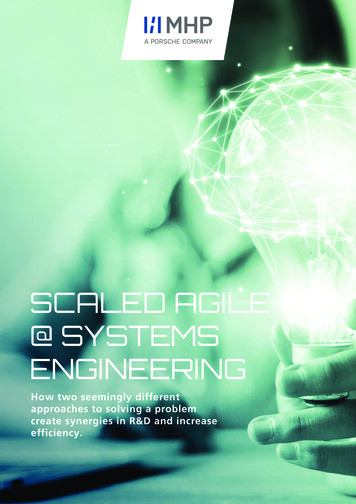
Transcription
Digital transformation, Digital disruptionAGILE TRANSFORMATION USINGSCALED AGILE FRAMEWORKSAFeSCALED AGILEPARTNERBRONZE
C O R P O R A T E P A C K A G ETABLE OF CONTENTSSituation Summary02Introduction03Seven Core Competencies of Lean Enterprise04Bene ts of SAFe05Organisation that use SAFe06Methodology / Interventions07SAFe Implementation Road Map11About LITT12w w w . l e a n i c o n t e c h n o l o g y . c o m1
C O R P O R A T E P A C K A G ESITUATION SUMMARYEnterprises must learn how to adapt quickly to changing technology andeconomic conditions or they will become extinct, no matter their size, strength oroutstanding ability. Companies that understand the urgency to move andadapt faster and change their ways of working will succeed. Those that don't,will struggle or simply go out of business. The business world is littered with iconicmarket leaders who zzled out because they couldn't adapt to new businessmodels and technology innovations ahead of their competitors.Digital transformations are changing the world, and in order to survive,enterprises must learn to adapt quickly. Even businesses that don't considerthemselves Information Technology (IT) or software companies, professionalservices, nancial services, manufacturers, healthcare institutions, governmentagencies and more, are now all highly dependent on their ability to producenew digital products and services.The introduction of technology into every facet of business has necessitated theneed to change cooperate culture and adopt new ways of working that willbring the needed organisational growth and survival. Agile practices andmethodologies have become relevant to most organisations, and has beenadopted to navigate digital transformation challenges and drive their businessforward.The agile approach to innovation and software development initially gainedpopularity in the technology sector but has since been adopted by a widerange of industries. As the name implies, agile emphasises speed and exibility,along with a strong customer focus. This growing recognition of itstransformational bene t, made it a unique business model to adopt at theenterprise level for ef cient anticipation and response to industry evolution andeconomic conditions. The move to an agile operating model is tough, mostorganisations still face unique challenges adopting agile as an operating modeland new way of working.LITT has been researching into various frameworks that can help with addressingthese challenges and discovered the positive business outcomes organisationsaround the world are achieving from adopting the Scaled Agile Framework(SAFe ).Embedding this framework into your organisation will improve its processes,allow for easy adoption of new technologies and increase innovation.w w w . l e a n i c o n t e c h n o l o g y . c o m2
C O R P O R A T E P A C K A G EINTRODUCTIONSAFe SCALED AGILE FRAMEWORKSAFe is an Agile project management framework which combines themethodologies of Lean and Systems thinking to integrate people, process,organisation strategy for the purpose of large-scale solution development andsoftware service/product deployment. It is a way to innovate and adapt quicklyto the fast changing market forces without losing momentum.While the bene ts are clear, before an enterprise can gain SAFe 's substantialbusiness bene ts, it must transform itself into a Lean enterprise.Thistransformation requires developing new enterprise competencies' that enable anew style of leadership, new ways of thinking and working, and a culture focusedon value delivery and continuous improvementw w w . l e a n i c o n t e c h n o l o g y . c o m3
C O R P O R A T E P A C K A G ESAFe for Lean Enterprises is a knowledge base of proven, integrated principles,practices, and competencies from Lean, Agile, and DevOps, that transform theculture and behaviour of an entire organisation.SEVEN CORE COMPETENCIES OF THE LEAN ENTERPRISEThey help an organisation adopt a Lean approach to delivering value in theshortest sustainable lead time with the highest quality and minimal wastingprocesses. Organisations that master the competences build essential musclememory and mindset that drive future success.OrganisationalAgilityLean PortfolioManagementEnterprise SolutionDeliveryAgile Product DeliveryTeam and TechnicalAgilityOptimizes business processes, evolution of strategy withclear and decisive new commitments, for quick adaptionof the organisation to capitalise on new opportunities.Aligns strategy and execution by applying Lean andsystems thinking approaches to strategy and investmentfunding, Agile portfolio operations, and governance.These value streams develop products or solutions forcustomers (or end-users), or they create solutions foroperational value streams.This is a customer-centric approach to de ning, building,and releasing a continuous ow of valuable productsand services to customers and users.This provides the critical skills and Lean-Agile principlesand practices that teams use to create high-qualitysolutions for their customers.Continuous LearningCultureThis describes a set of values and practices thatencourage individuals and the enterprise as a whole-tocontinually increase knowledge, competence,performance, and innovation.Lean - AgileLean-Agile Leaders drive and sustain organizationalchange and operational excellence by empoweringindividuals and teams to reach their highest potential.Leadership Scaled Agile, Inc.w w w . l e a n i c o n t e c h n o l o g y . c o m4
C O R P O R A T E P A C K A G E BENEFITS OF SAFeAGILE ORGANISATION TRADEMARKS AND PRACTICESTRADEMARKS AND PRACTICESFEATURESTRADEMARKSPRACTICESStrategyShared strategy acrossorganisation· Shared purpose and vision· Sensing and seizing opportunities· Flexible resource allocation· Actionable strategic guidanceStructureNetwork of empoweredteams· Clear, at structure· Clear accountable roles· Hands-on governanceProcessRapid decision and learningcycles· Action-oriented decision making· Rapid iteration and experimentation· Information transparency· Performance orientationPeopleDynamic people that ignitepassion· Shared and servant leadership· Entrepreneurial drive· Cohesive community· Role mobilityTechnologyNext generation enablingtechnologyw w w . l e a n i c o n t e c h n o l o g y . c o m· Evolving technology architecture,systems, and tools· Next-generation technologydevelopment and deliverypractices5
C O R P O R A T E P A C K A G EORGANISATIONS THAT USE SAFew w w . l e a n i c o n t e c h n o l o g y . c o m6
C O R P O R A T E P A C K A G E3.0METHODOLOGY / INTERVENTIONSLITT is a rm that provides large scale agile enterprise transformation andconsulting services to our clients that enables them to adjust to and manage therapidly changing enterprise demands that most organisations are confrontedwith today. LITT teaches and leverages Agile methodologies such as Scrum,Kanban, Extreme Programming (XP), and the Scaled Agile Framework (SAFe )while also coaching our clients in effective DevOps processes to increase the ow of value within the organisation.Whilst many of the challenges that different organisations face in implementingAgile are often the same, the solutions to those challenges are like theorganisations themselves, always unique. Moreover, organisations andcircumstances change so what is the best solution today is unlikely to be the bestsolution tomorrow. With this in mind, the LITT approach emphasises, above allelse, the importance of continuous evolutionary improvement.We understand that what is right for one organisation or project is not necessarilyright for another, and so LITT will help you select, tailor, de ne and implement thebest Lean and Agile approach for your business circumstances. This will beachieved using the following steps;1.Strategy and Organisational Agile Leadership2.Business Analysis and Agile Pilot3.Scaling Agile and SAFe Training4.Coaching and Operational ExcellenceIt is recommended that services will be provided in the four steps stated, as andwhen value is delivered, your organisation will decide to move to the next stageof the implementation road map. LITT will train staff of your organisation as SAFe Consultants who will guide the implementation process.w w w . l e a n i c o n t e c h n o l o g y . c o m7
C O R P O R A T E P A C K A G E3.1STRATEGY AND ORGANISATIONALAGILE LEADERSHIPSuccessful agile transformations need strong and aligned leadership from thetop, we would train and work with the leadership team to understand andsupport with the delivery of the Agile Transformation. The Balance Score Cardand Target Operating Model (TOM) will be used to support the delivery ofoperational excellence and new initiatives using the Scaled Agile Frameworkand best practices that enable ef ciency. Where the organisation has anexisting strategy, we will provide guidance on the organisations strategy andwork with the Leadership team to implement the strategic initiatives using theScaled Agile Framework.The approval of the framework by management team will then allow for furtheranalysis of the business and speci c dates will be proposed for the training ofvarious teams within the organisation. The dates for any other meetings andworkshops will be agreed subject to the availability of management and thewider team within the organisation.w w w . l e a n i c o n t e c h n o l o g y . c o m8
C O R P O R A T E P A C K A G E3.2BUSINESS ANALYSIS ANDAGILE PILOTOur business analysts will identify business needs and best approach for smoothorganisation agile journey, in addition identify where agile way of working canhave veri able impacts. The purpose of a pilot is to demonstrate the value ofagile ways of working through tangible business outcomes.LITT's organisational transformation consultants will experiment series of agilepilots involving multiple teams to test the broader elements of enterprise agility.We will build an Organisation Lean Agile Centre of Excellence team to draw aroadmap and keep the teams focused on achieving strategic outcomes. Theroadmap of activities will embed process change, mindset change and culturalchange. The following roles are recommended and existing staff will be trainedto act effectively in these roles;····Program LeadScrum MasterProduct OwnerBusiness Analyst.LITT designs and develops courses, and can make business-speci c additionsaccording to the needs of your staff and organisation. Our experiencedconsultants provide corporate clients with tailored solutions that help theirbusinesses become more ef cient and pro table. It's recommended that thisinitial consultation phase should last for a maximum of 3 months after whichprogress would be evaluated considering the objectives delivered to determinethe next steps of delivering the rst Value Stream.w w w . l e a n i c o n t e c h n o l o g y . c o m9
C O R P O R A T E P A C K A G E3.3SCALING AGILEIN ORGANISATIONScaling beyond a few pilots is where most agile transformations fail. It requiresrecognition from leadership that scale-up will require a strategic, structural,process, people and technology mind-set shift, and a signi cant portion of keyleaders' time, as well as willingness to role model new mind-sets and behaviorswill be very important. After the leadership team has undergone training, thenext step will be to work with management and the wider team to manage agileat scale to deliver the Value Stream. The following training will be provided to thevarious teams within the organisation;1. Leading SAFe 2. SAFe Scrum Master3. SAFe Product Owner/ Product Manager4. SAFe for TeamsThe strategy in achieving the objectives would include, but not be limited to, thefollowing activities:ŸAgile Cell Deployment Across Enterprise:An organisation can't pilot its way to enterprise agility. Thus, we will build moreagile teams and work with management to facilitate resources and appropriateworkspace required for successful and sustainable independent team building,nurture and collaborationSpine Transformation:The backbone governs how decisions get made; how people, budgets andcapital get deployed; and how risk gets managed. Scaling agile in anorganisation to operating model requires that this backbone be transformed.Thus, our consultants will work with management to ensure agile new ways ofworking are aligned and supported with broader organisational philosophies(processes, systems, and even beliefs and values).ŸŸAgile Capacity Building:Scaling an agile operating model requires new skills, behaviors and mind-setsacross the organisation. Most organisations require existing staff to take on thesenew roles or responsibilities, and as such, need a way to build new skills andcapabilities. Whichever way, our agile trainers will develop and certify agilecoaches within the organisation to ensure sustainable progress in theorganisations agile journey and also, create an enabling environment forcontinuous learning and improvement across the organisation.Culture and Change ManagementA culture and change team is an essential coordinating element of an agiletransformation. But it is not a traditional project-management of ce; rather, the .Ÿw w w . l e a n i c o n t e c h n o l o g y . c o m10
C O R P O R A T E P A C K A G Eemphasis should be on enabling the other transformation elements, helping toremove impediments and catalyzing culture change. The importance ofinvesting in culture and change on the journey to agility cannot be overstated.Agile is, above all, a mind-set, without the right mind-set, all other parts of theagile operating system can be in place, and yet companies will see few bene ts.Consequently, our consultants will help leaders and teams have a strong agilemind-set for easy acceptance of agile way of working.3.4COACHING AND OPERATIONALEXCELLENCECoaching and operational excellence can be initiated after a successfulimplementation of Agile transformation. The following
Ÿ Agile Capacity Building: Scaling an agile operating model requires new skills, behaviors and mind-sets across the organisation. Most organisations require existing staff to take on these new roles or responsibilities, and as such, need a way to build new skills and capabilities. Whichever way, our agile trainers will develop and certify agile

